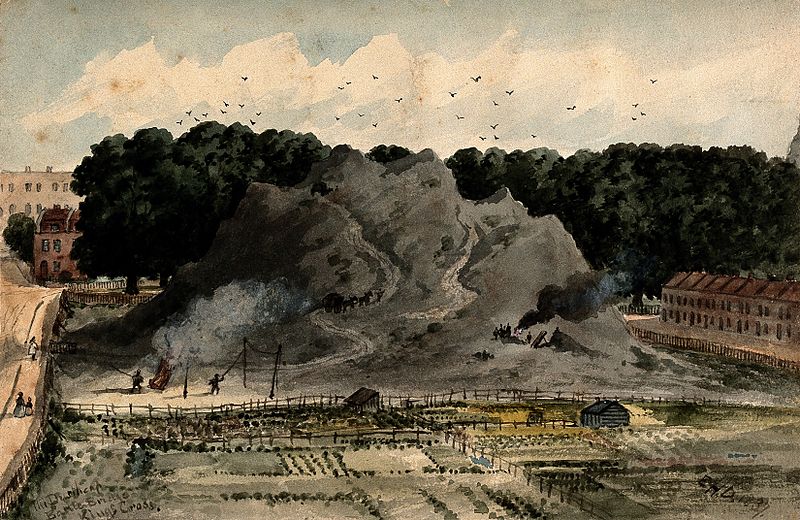Dust heap
|
This watercolour painting depicts King's Cross, London: the Great Dust Heap, next to Battle Bridge and the Smallpox Hospital by E H Dixon (1837). Notations associated with the painting describe it as a ‘View of the Great Dust Heap, King’s Cross, Battle Bridge, from the Maiden Lane (the present York Road). It was removed in 1848 to assist in rebuilding the City of Moscow, Russia.’ |
Contents |
[edit] Introduction
Dust heaps were human-made mountains of ash, cinders and combustible domestic waste or soil that accumulated around London during the 19th century. These piles of fine dust, clinker, breeze (or brieze) and other household rubbish were created by the large amounts of coal used in London from roughly 1800 to 1850. During this period, it was thought that each London household used as much as 11 tons of coal annually for domestic fires.
[edit] Early waste collection method
This form of waste management was initially instituted for practical safety purposes. It was thought that the large quantity of ash residue - if left uncollected - would block passageways and create other hazards in London.
To combat the safety issue of unmanaged household waste - which was also becoming a public eyesore - communities employed dust contractors who would be hired to collect and transport the material to the dust heaps on the outskirts of the city. For those in the dust collection market, this became a lucrative business, since the materials held varying degrees of value once separated out by labourers known as sifters or scavengers.
Domestic waste (or soil) was sold to farmers for manure. Cinders, ash, clinker and breeze were sold to brickmakers (as fuel for burning and material for making building materials; this is the origin of the terms breezeblock - or briezeblock - and cinderblock in the US). Other salvageable items (such as discarded pans and pottery) were also recovered and set aside for possible sale or reuse.
[edit] The Great Dust Heap of King’s Cross
Dust heaps were a fixture in London during Victorian times. In Our Mutual Friend by Charles Dickens, dust heaps were the source of wealth for Nicodemus (Noddy) Boffin, a lowly clerk who inherits several dust heaps from his employer and becomes The Golden Dustman. These vast piles were extremely valuable, but when it became necessary to address public sanitation issues in the 1850s, the phase out process began.
One of the most valuable and extensive of these sites in London was the Great Dust Heap. In 1848, this vast mountain was removed to make way for King’s Cross Station (which was part of the newly commissioned Great Northern Railway).
According to Vic Keegan’s Lost London 109: The Great Dust Heap, “Contemporary accounts – including W J Pinks’s venerable survey of Clerkenwell – report that the dust heap was sold – wait for it – to the government of Russia to help the re-building of Moscow after the war with Napoleon for an estimated price of £20,000.”
[edit] Related articles on Designing Buildings
- A heritage partnership agreement for King's Cross Station.
- Blockwork.
- Civil Engineering during the Industrial Revolution in Britain.
- Clinker in construction.
- Coal ash.
- Environmental engineering.
- King's Cross Station Redevelopment.
- Miasma theory.
- Three pieces of infrastructure that have saved lives.
- Waste management - explained.
[edit] External resources
- Victor Keegan, On London, Lost London 109: The Great Dust Heap.
IHBC NewsBlog
Images from inside a Grade II listed hotel show the scale of its collapse
The Corbett Arms in Tywyn has fallen into serious disrepair.
Old Sarum fire in listed (& disputed) WW1 Hangar - Wiltshire Council has sought legal advice after fire engulfed a listed First World War hangar that was embroiled in a lengthy planning dispute.
UK Antarctic Heritage Trust launches ‘Virtual Visit’ website area
The Trust calls on people to 'Immerse yourself in our heritage – Making Antarctica Accessible'
Southend Council pledge to force Kursaal owners to maintain building
The Council has pledged to use ‘every tool in the toolbox’ if urgent repairs are not carried out.
HE’s Research Magazine publishes a major study of the heritage of England’s suburbs
The article traces the long evolution of an internal programme to research 200 years of suburban growth
IHBC Context 183 Wellbeing and Heritage published
The issue explores issues at the intersection of heritage and wellbeing.
SAVE celebrates 50 years of campaigning 1975-2025
SAVE Britain’s Heritage has announced events across the country to celebrate bringing new life to remarkable buildings.
IHBC Annual School 2025 - Shrewsbury 12-14 June
Themed Heritage in Context – Value: Plan: Change, join in-person or online.
200th Anniversary Celebration of the Modern Railway Planned
The Stockton & Darlington Railway opened on September 27, 1825.
Competence Framework Launched for Sustainability in the Built Environment
The Construction Industry Council (CIC) and the Edge have jointly published the framework.















